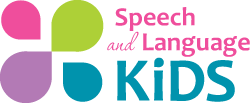This fun therapy activity will let you work on grammar skills like pronouns and verb tenses while you’re playing with sock puppets. It’s cheap, it’s easy, and it’s SUPER fun! Check it out:
Materials:
- Two Sock Puppets: Use tube socks and hot glue eyes and hair onto them. Make sure one looks like a boy and one looks like a girl. I added pigtails and a necklace to my girl (well, until my 18-month-old pulled the pigtails off). Also, make sure to cut a hole in the mouth of each puppet so the food can go all the way through. For complete instructions on how to do this, click the button below to download the PDF instructions.
- Tiny play food: I used Barbie food but you could also use the paper food I have included in the PDF instructions for this activity:
Set Up:
- Put one puppet on each hand
- Keep the food in a separate container that the child doesn’t have access to. You want to give him the food one piece at a time.
Target Skills:
This activity is good for working on all kinds of grammar, but specifically these goals:
- Use of “he” or ”she” in response to “who will eat this one?”
- Use of “his” or “her” in response to “whose ___ is this?”
- Use of possessive ‘s in response to “whose ___ is this?”
- Use of proper verb tenses like future tense (he is going to eat), present tense (he is eating), and past tense (he ate).
Video Example:
This video shows how to use the sock puppets to work on “he” and “she” as well as to model verb tenses:
How to Work on He/She:
- Ask the child “who is going to eat the ___? Is HE going to eat it or is SHE going to eat it?”
- When the child indicates which puppet will eat it, respond with “HE is going to eat it” or “SHE is going to eat it”. Then, tell the child why you say he or she (example: “This is a boy so we say “he”).
- Encourage the child to imitate the sentence (he is going to eat it) or just the pronoun by itself (he).
- Let the child feed the puppet and then start over again.
How to Work on His/Her:
- Ask the child “Whose ___ is this? Is it HIS ___ or HER ____?”
- When the child indicates which puppet it belongs to, respond with “It’s HIS ___” or “It’s HER ____”. Then, tell the child why you say his or her (example: “This is a boy so we say “his”).
- Encourage the child to imitate the sentence (it’s his banana) or just the pronoun by itself (his).
- Let the child feed the puppet and then start over again.
How to Work on Possessive ‘s:
- Give the puppet random names.
- Ask the child “Whose ___ is this? Is it Bobby’s ___ or Sally’s ____?”
- When the child indicates which puppet it belongs to, respond with “It’s Bobby’s ___” or “It’s Sally’s ____”. Then, tell the child why you say the /s/ sound (example: “When we’re talking about something that belongs to someone, we add a /s/ sound”).
- Encourage the child to imitate the sentence (it’s Bobby’s banana) or just the word by itself (Bobby’s).
- Let the child feed the puppet and then start over again.
How to Work on Verb Tenses:
** You can model this during any of the other activities or do this separately.
- Choose one puppet to use for this activity. You can choose a name for the puppet or use the pronouns “he” and “she”.
- Put one piece of food in front of the puppet. Say “he is going to eat the ___” or “he will eat the ____”.
- Then, have the child put the food in the puppet’s mouth and while it’s in the mouth say “he is eating the ____”.
- Then, “swallow” the food by pushing it down the hole and show the child that the puppet’s mouth is empty. Say “He ate the ____”.
- Do this again but this time, ask the child “what’s happening?” each step of the way and see if he can use the correct verb forms.
Your Next Steps:
Click the button below to download the PDF instructions for how to make the puppets and how to do the activities. It also includes printable pictures for miniature food you can use during this activity.
More Resources for Speech-Language Pathologists:
Looking for more therapy ideas and resources to help you provide the BEST services to your clients? Join us in The SLP Solution, our membership program for speech-language professionals! Inside the membership, you'll find:
- Step-By-Step Guides for teaching a variety of speech/language/communication skills
- Pre-Made Worksheets and Therapy Activities for hundreds of different topics
- Training Videos for dealing with difficult disorders or problems
- Answers to Your Questions in our exclusive SLP community
- Tools and Resources to help you with your paperwork and admin tasks
- Continuing Education through our monthly webinars and webinar recordings
To join us in the full SLP Solution, or to snag a free membership, click on the button below!
Podcast: Play in new window | Download | Embed
Subscribe: Apple Podcasts | RSS






Leave A Comment